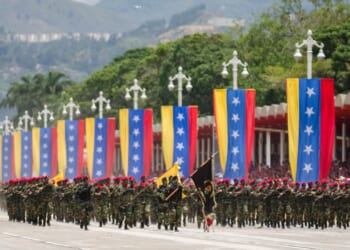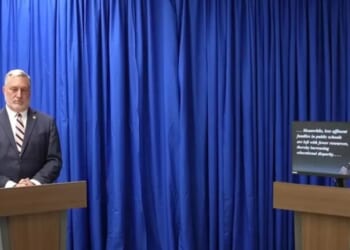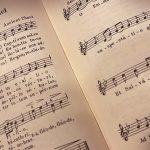The Detroit Symphony Orchestra has been carving out a reputation for itself as the definitive performer of Wynton Marsalis’s music. Earlier this year it released a recording of Marsalis’s Blues Symphony, an effort that has since earned a Grammy nomination. And this fall’s Classical Season included a performance of Marsalis’s Violin Concerto (composed in 2015) with Italian violinist Giuseppe Gibboni as the soloist. This American-music focus is par for the course for the DSO, which has consistently prioritized American composers such as John Williams, John Adams, Aaron Copland, William Grant Still, and Samuel Barber.
Marsalis is a good choice. Beyond Stephen Hough, I can think of very few people at the highest level of music that fall as easily into the category of “polymath” as Marsalis does. As both a trumpeter and composer in both classical and jazz, Marsalis has a unique and dynamic ability to see across the divide. Gershwin aside, the worlds of jazz and classical music have historically struggled to find common ground. Yet Marsalis has produced a body of work that seems to have cracked the code.
His violin concerto is the ultimate representation of this cross-genre brilliance. It fuses American fiddling and jazz with the Western classical tradition into a complex and virtuosic whole. There is an improvisatory element to the piece, particularly in the solo part, which alternates between dreamlike lyricism and furious tirades that span the entire length of the violin’s fingerboard. Perhaps the best example of this is the cadenza before the third movement, “Blues”, in which the soloist walks back through the orchestra to play various passages with the drummer. The music alternates between a rolling march theme and moments of shimmering hesitation, as if the violin is caught between sleeping and waking. The two slow movements I found a bit drawn-out and long-winded, but the rollicking, foot-stomping fun of the final movement, “Hootenanny,” made up for that. (The string players do, in fact, stomp their feet to begin the movement.) This is raucous, joyous music, a masterly transformation of the rural American fiddling tradition into concert-hall music of the highest order.
This is a fiendishly difficult piece, too. But Gibboni was up for the challenge. He possesses a lithe and supple technique, particularly in the left hand, and his sound has an airy sweetness that is reminiscent of Joshua Bell’s. He has all the marks of a budding virtuoso, including a seemingly endless appetite for difficult pieces. Indeed, after the concerto he rewarded the audience’s multiple ovations with Heinrich Wilhelm Ernst’s staggeringly difficult étude “The Last Rose of Summer,” tossing it off—left-hand pizzicato and all—as if it were a simple child’s exercise. I would’ve liked a bit more body to his sound, particularly in the lyrical passages, which seemed at times to disappear under even the lightest dynamics of the orchestra. Leonidas Kavakos comes to mind here, with his ability to carry even a pianissimo line to the back of a concert hall with remarkable clarity. But this is a minor quibble. If this performance was any indication, Gibboni will be around for a while yet.
The second half of the program featured Shostakovich’s Ninth Symphony, composed in 1945. This is the most lighthearted of Shostakovich’s symphonic compositions, but it was not intended to be. Shostakovich’s Ninth Symphony was expected to be a celebratory composition, like Beethoven’s Ninth, featuring a monumental orchestration, vocal soloists, and a full chorus. “They wanted a fanfare from me, an ode,” he is claimed to have said in Testimony, a memoir allegedly dictated by Shostakovich. “Everyone praised Stalin and now I was supposed to join in the unholy affair.” But as World War II came to a close, he set aside his draft and instead wrote the spry, brief, and somewhat neoclassical symphony we now know as his Ninth. In Testimony, Shostakovich is quoted as saying “I couldn’t write an apotheosis to Stalin, I simply couldn’t.” Needless to say, the premiere received mixed reactions, and Stalin was outraged. One American reviewer even wrote: “Shostakovich should not have expressed his feelings about the defeat of Nazism in such a childish manner.”
But Shostakovich was onto something. For one, the Ninth is an incredibly fun piece to play, and Shostakovich knew it. “Musicians will love to play it,” he said, “and critics will delight in blasting it.” On a deeper level, though, Shostakovich appears to have built into the Ninth Symphony the bitter irony of Russia’s military victory. He knew that winning the war came at a monstruous human cost to the Soviet Union. Some observers have noted that the Ninth Symphony seems to contain parodic presentations of victory marches that are harmonically and rhythmically tweaked in subtle ways that make them unsettling, even eerie. Rather than being childish or outrageous, the Ninth Symphony is Shostakovich at his most prescient.
I have never heard the first, third, and fifth movements played as fast as I did in this concert; yet the rollicking pace seemed to be exactly what the music wanted. A fast, youthful presentation is necessary for this symphony, and the DSO proved more than up to the task. The strings were fleet-footed in the sixteenth-note passages, and the brass lines were crisp and energetic. The music director Jader Bignamini teased out the chamber-music character of the symphony without neglecting to emphasize the characteristic absurdities Shostakovich so loved to hide in his scores. The piccolo’s use of the tragic second theme to cut off the trombone’s repeated attempts to introduce a victorious fanfare in the first movement, for instance, was downright hilarious.
Yet for all the excitement of the fast movements, it was the dark, ironic second and fourth movements that anchored the symphony. The second movement begins with a melancholy clarinet solo, based on a Jewish folk tune, that slowly rises over an almost standstill ensemble, perhaps representing Stalin’s persecution of Soviet Jews. The strings then enter with an unsettling, swaying figure that builds to a tragic climax before returning to the initial solo voice, this time played by the flute. The fourth movement is even darker, alternating between a solemn, almost angry motif from the trombones and a series of somber but expressive bassoon solos. The principal bassoonist Conrad Cornelison deserves particular mention here for his tasteful presentation of the bassoon line.
Shostakovich and Marsalis are not often programmed together. Yet I think these pieces do, in fact, work well in tandem, much as the massive Brahms Violin Concerto works well with a lighter symphonic work like Prokofiev’s Classical Symphony or Copland’s Dance Symphony. They contrast with each other in length and style, and they draw from different historical contexts, but both works are based, at least in part, on local folk-music traditions. Both works are also unafraid of embracing the jovial, the light, even the absurd. They are both, in a word, youthful, and one could do worse than spend an evening in their presence.
















